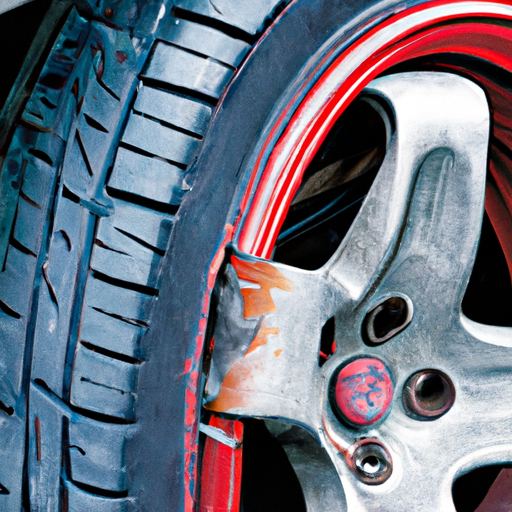Have you ever wondered if a bent wheel can be balanced? In this article, we will explore this intriguing question and provide you with the answer you’ve been seeking. Whether it’s a result of hitting a pothole or a curb, a bent wheel can cause vibrations and affect your driving experience. But is it possible to balance a wheel that has been bent? Stay tuned as we uncover the truth behind this common automotive concern.
Understanding Bent Wheels
What causes a wheel to become bent?
Bent wheels are a common issue that many vehicle owners encounter at some point. There are several factors that can cause a wheel to become bent. The most common cause is hitting a pothole or a curb at a high speed. This impact can cause the wheel to deform, resulting in a bend.
Other causes of bent wheels include driving over rough terrain, hitting large objects on the road, and even accidents. The force exerted on the wheel during these incidents can cause it to warp or buckle, affecting its shape and balance.
Detecting a bent wheel
Detecting a bent wheel is crucial to ensure the safety and optimal performance of your vehicle. There are a few signs that can indicate a bent wheel. One of the most obvious signs is a noticeable wobble or vibration while driving. If you feel a shaking sensation in the steering wheel or the car itself, it might be an indication of a bent wheel.
Another way to detect a bent wheel is by inspecting the wheel visually. Look for any visible signs of damage, such as dents, cracks, or misalignment. You can also check the tire for any bulges or uneven wear, which can be a result of a bent wheel.
Effects of a bent wheel on vehicle performance
A bent wheel can have various effects on the performance of your vehicle. One of the most noticeable effects is a decrease in ride quality. The wobbling or vibrations caused by a bent wheel can make your drive uncomfortable and even pose a safety risk.
Moreover, a bent wheel can affect the alignment and balance of your vehicle’s tires. This imbalance can lead to uneven tire wear, reducing the lifespan of your tires. It can also cause the vehicle to pull to one side, affecting its overall handling and stability. Additionally, a bent wheel can impact the accuracy of the tire pressure monitoring system (TPMS), making it difficult to maintain the proper tire pressure.
Can a Bent Wheel Be Repaired?
Factors affecting repairability
Whether a bent wheel can be repaired or not depends on several factors. The severity of the damage is one of the primary factors to consider. Minor bends or warps can often be repaired, but if the wheel is severely bent or cracked, it may not be salvageable.
The type of wheel material is also an essential factor. Aluminum wheels are typically more repairable than steel wheels because they have a greater flexibility. Steel wheels are more prone to cracking under stress, which limits their repairability.
Methods for repairing bent wheels
There are a few methods used to repair bent wheels, depending on the severity of the damage. One common method is hydraulic straightening, which involves using specialized machinery to apply force to the bent area, gradually restoring it to its original shape.
Another method is known as rim rolling or rim heating. This process involves applying heat to the bent area, followed by reshaping the wheel using a hydraulic press. This method can be effective for wheels with minor bends or warps.
However, it is important to note that not all wheels can be repaired. If the damage is extensive or the wheel is heavily corroded, it may be necessary to replace the wheel instead of attempting a repair.

Balancing a Bent Wheel
The importance of wheel balancing
Wheel balancing is an essential aspect of maintaining the overall performance and safety of your vehicle. When a wheel is properly balanced, it rotates evenly without any vibrations or wobbling. This ensures a smooth ride and reduces the stress on various components of the vehicle, such as the suspension and steering system.
Can a bent wheel be balanced?
In some cases, a bent wheel can be balanced to a certain extent. However, it is important to note that balancing a bent wheel is not always a permanent solution. Balancing can help minimize the vibrations and wobbling caused by a bent wheel, but it may not completely eliminate the issue.
Challenges in balancing a bent wheel
Balancing a bent wheel can be challenging due to the irregular shape and weight distribution caused by the bend. Wheel balancing machines rely on precise measurements and adjustments to achieve an optimal balance. If the wheel is significantly bent, it may be difficult to achieve the desired balance, even with advanced balancing equipment.
Moreover, attempting to balance a severely bent wheel may put additional stress on the already damaged areas, potentially worsening the problem. It is important to consult a professional technician to assess the extent of the damage and determine the appropriate course of action.
Professional Wheel Balancing
Advantages of professional wheel balancing
Opting for professional wheel balancing offers several advantages. Firstly, professional technicians have access to specialized equipment and tools designed specifically for wheel balancing. This ensures accurate measurements and adjustments, resulting in a more precise balance.
Secondly, professional wheel balancing services often include a thorough inspection of the wheels and tires. This allows the technician to identify any other potential issues, such as tire wear or alignment problems, which can be addressed simultaneously.
Lastly, professional wheel balancing can save you time and effort. Instead of attempting to balance the wheels yourself, which can be tricky and time-consuming, you can rely on the expertise of trained professionals to get the job done efficiently.
The process of professional wheel balancing
During a professional wheel balancing service, the technician will first assess the condition of the wheels and tires. They will then use a wheel balancing machine to measure the weight distribution of the wheel. Based on these measurements, the technician will add or remove weights to achieve a proper balance.
The technician will also inspect the tires for any signs of wear or damage and check the alignment of the wheels. If any issues are detected, they can make the necessary adjustments or recommendations for further repairs.
Costs associated with professional wheel balancing
The cost of professional wheel balancing can vary depending on several factors, such as the location, the type of vehicle, and the extent of the service required. On average, the cost of wheel balancing can range from $20 to $100 per wheel. It is advisable to contact local service providers to get an estimate for your specific vehicle.

DIY Wheel Balancing
When is DIY wheel balancing suitable?
DIY wheel balancing can be a suitable option for minor wheel imbalances or as a temporary fix until a professional service is available. If you have experience working with cars and access to the necessary tools, you can attempt to balance the wheels yourself.
However, it is important to note that DIY wheel balancing has its limitations, especially when dealing with bent wheels or significant imbalances. For complex issues or if you are unsure about the process, it is recommended to seek professional assistance.
Tools and equipment needed for DIY wheel balancing
To perform DIY wheel balancing, you will need a few essential tools and equipment. These include a wheel balancing stand or balancer, wheel weights, and a lug wrench or torque wrench for removing and reinstalling the wheels. Additionally, a tire pressure gauge is recommended to ensure the tires are inflated to the correct pressure.
It is crucial to follow the instructions provided with the wheel balancing equipment and to use proper safety precautions during the process.
Step-by-step guide for DIY wheel balancing
Here is a general step-by-step guide for DIY wheel balancing:
- Safely jack up the vehicle and secure it with jack stands.
- Remove the wheel from the vehicle using the lug wrench or torque wrench.
- Clean the wheel thoroughly to remove any dirt or debris.
- Set up the wheel balancing stand or balancer according to the manufacturer’s instructions.
- Mount the wheel onto the balancing stand or balancer and ensure it is securely in place.
- Use the wheel balancing equipment to determine the imbalance of the wheel.
- Add or remove wheel weights as needed to achieve a balanced position.
- Reinstall the wheel onto the vehicle using the lug wrench or torque wrench.
- Repeat the process for each wheel that requires balancing.
- Test drive the vehicle to ensure a smooth ride and proper balance.
Remember, DIY wheel balancing may not provide the same level of accuracy and precision as professional services. If you encounter any difficulties or are unsure about the process, it is best to consult a professional technician.
Temporary Fixes for Bent Wheels
When temporary fixes are necessary
There may be situations where a temporary fix for a bent wheel is necessary. For example, if you are on a road trip or far from a service center, and a bent wheel is affecting the vehicle’s driveability, a temporary solution can help you reach the nearest repair facility safely.
Additionally, if the cost of immediate wheel repair or replacement is not feasible, a temporary fix can provide a temporary solution until you can afford a permanent fix.
Options for temporary fixes
One temporary fix for a bent wheel is using a rubber mallet to gently hammer the bent area back into shape. This method can provide some temporary relief by reducing the severity of the bend. However, it is important to note that this is not a permanent solution and should only be used in emergencies.
Another option is using a wheel straightening kit, which typically includes a hydraulic jack and various tools to provide some degree of wheel straightening. While this method can be more effective than using a rubber mallet, it still does not provide the same level of precision as professional wheel straightening services.
Limitations and risks of temporary fixes
Temporary fixes for bent wheels have limitations and risks that should be considered. These fixes may only provide temporary relief and may not completely correct the issue. The bent wheel could continue to cause vibrations and affect the overall performance of the vehicle.
Moreover, attempting a temporary fix without proper knowledge or tools can potentially cause further damage to the wheel or other components of the vehicle. It is important to remember that temporary fixes are not a replacement for proper repairs or maintenance.

Preventing Wheel Damage
Proper tire maintenance
Proper tire maintenance plays a crucial role in preventing wheel damage. Regularly inspecting the tires for any signs of wear or damage allows you to address any issues before they worsen. Maintaining the recommended tire pressure and rotating the tires as specified by the manufacturer also helps prevent uneven wear and imbalances that can lead to bent wheels.
Additionally, it is important to keep an eye on the tread depth of the tires. Worn-out tires with insufficient tread can reduce traction and increase the risk of hitting potholes or other road hazards, potentially causing wheel damage.
Safe driving practices
Practicing safe driving habits can significantly reduce the risk of bent wheels. Avoiding excessive speed, especially over rough roads or pothole-infested areas, can minimize the impact on the wheels. Maintaining a safe distance from the vehicle ahead allows you to anticipate and avoid road hazards, reducing the chances of hitting curbs or large objects.
Additionally, avoiding aggressive maneuvers, such as sudden braking or sharp turns, can prevent excessive stress on the wheels and suspension components.
Avoiding potholes and road hazards
Potholes and road hazards are common culprits for bent wheels. Being vigilant and aware of the road conditions can help you avoid these hazards. When encountering a pothole, slow down and try to steer around it if it is safe to do so. If avoidance is not possible, reduce your speed as much as possible to minimize the impact on the wheels.
It is also advisable to be cautious when driving on poorly maintained roads, construction zones, or areas with debris on the road. A proactive approach can go a long way in preventing wheel damage.
Replacing a Bent Wheel
Determining the need for wheel replacement
In some cases, a bent wheel may be beyond repair and require replacement. Determining the need for wheel replacement depends on several factors, such as the severity of the bend, the condition of the wheel material, and the cost-effectiveness of repair versus replacement.
If the wheel is severely bent or cracked, it may not be safe or feasible to repair it. Additionally, if the cost of repair is close to or surpasses the cost of a new wheel, it is often more practical to opt for a replacement.
Choosing a replacement wheel
When selecting a replacement wheel, several factors should be considered. Firstly, it is important to choose a wheel that is compatible with your vehicle’s specifications, including the correct size, bolt pattern, and offset. Consult your vehicle’s manufacturer or a reputable wheel dealer for guidance in selecting the appropriate replacement.
Additionally, consider the material and design of the wheel. Aluminum wheels are commonly chosen for their lightweight properties and aesthetics. However, steel wheels can be a more cost-effective option for certain vehicles or driving conditions.
Lastly, consider your personal preferences and budget when choosing a replacement wheel. There are various options available, ranging from basic designs to more intricate and stylish choices.
Installation and alignment considerations
Installing a replacement wheel should be done carefully to ensure proper fitment and alignment. It is recommended to have the replacement wheel installed by a professional technician with the necessary expertise and equipment.
Once the new wheel is installed, it is important to have the vehicle’s alignment checked and adjusted if necessary. A bent wheel can cause misalignment, which can lead to uneven tire wear and handling issues. Proper alignment ensures the wheels are positioned correctly, ensuring optimal performance and longevity.

Wheel Straightening Services
What are wheel straightening services?
Wheel straightening services are professional services that specialize in repairing and restoring bent wheels. These services employ advanced equipment and techniques to effectively straighten the damaged wheels.
Benefits of wheel straightening
There are several benefits to opting for professional wheel straightening services. Firstly, wheel straightening can often be a more cost-effective solution compared to wheel replacement, especially if the damage is not severe. This can save you money while ensuring the wheel is restored to its proper form and function.
Secondly, wheel straightening services can help maintain the originality and aesthetics of your wheels. If you have unique or high-end wheels, finding an exact replacement can be difficult and costly. Wheel straightening allows you to preserve the original wheel while resolving any bending issues.
Lastly, wheel straightening services are performed by experienced technicians who have the necessary expertise to accurately assess and repair bent wheels. This ensures a professional and reliable solution for your wheel damage.
Finding a reputable wheel straightening service
When seeking a wheel straightening service, it is important to find a reputable provider. Look for service centers or technicians who specialize in wheel straightening and have a proven track record of successful repairs.
Research reviews and ask for recommendations from trusted sources to ensure you choose a reliable service provider. Additionally, inquire about the equipment and techniques used, as well as any warranties or guarantees offered for their services.
Conclusion
The importance of addressing bent wheels
Understanding bent wheels, their causes, and effects is crucial for maintaining the safety and performance of your vehicle. Ignoring or neglecting bent wheels can lead to further damage and compromise the overall driving experience.
Choosing the appropriate solution for wheel repair
When faced with a bent wheel, it is essential to assess the severity of the damage and consider various factors such as repairability, costs, and long-term viability. In some cases, professional wheel balancing or straightening services can effectively restore the wheel to its original condition. Other times, wheel replacement may be necessary for safety and optimal performance.
By addressing bent wheels promptly and choosing the appropriate solution, you can ensure a smooth and safe ride while prolonging the lifespan of your wheels and tires. Whether you opt for professional services or attempt DIY solutions, prioritize the well-being of your vehicle and consult experts when needed.


